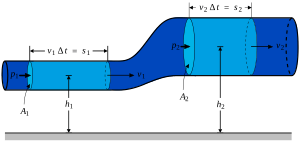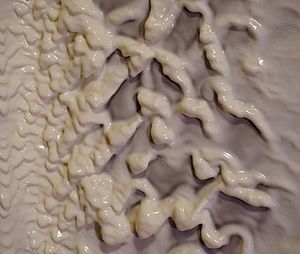Non-Newtonian fluid facts for kids
| Mechanics | ||||||||||

|
||||||||||
A non-Newtonian fluid is a special type of fluid. Its thickness, or viscosity, changes when you apply force to it. Imagine pushing on it or stirring it quickly. This is different from common liquids like water. Water always flows the same way, no matter how hard you push it.
The way these fluids flow can also change. Their thickness often depends on how fast they are being pushed or pulled. It can also depend on their past movements. Common examples include blood, quicksand, and some parts of cement. Many lubricants, ketchup, and even some types of dough and pudding also act this way.
Fluids that do not change their thickness with force are called Newtonian fluids. Water and oil are good examples of Newtonian fluids.
You can easily make a non-Newtonian fluid at home. All you need is water and cornstarch. Mix one part cornstarch with one and a half parts water. This creates a fun, squishy non-Newtonian fluid!
Contents
What is a Non-Newtonian Fluid?
A non-Newtonian fluid does not follow Isaac Newton's law of viscosity. This law says that a fluid's thickness stays the same. It does not matter how much force you put on it. Non-Newtonian fluids break this rule. Their thickness changes with the force.
How Does Viscosity Change?
The viscosity of these fluids can change in different ways. Some fluids get thicker when you push them hard. Think of cornstarch and water mixture. If you punch it, it feels solid. If you slowly dip your hand in, it feels like a liquid.
Other non-Newtonian fluids get thinner when you apply more force. Ketchup is a good example. It is hard to get out of the bottle at first. But if you shake the bottle hard, it flows out easily. This is because shaking makes it thinner.
Shear Rate and Viscosity
The "shear rate" is how fast different layers of a fluid move past each other. For non-Newtonian fluids, their viscosity depends on this shear rate.
- Shear-thickening fluids get thicker as the shear rate increases. This means they become more solid-like when you apply force quickly.
- Shear-thinning fluids get thinner as the shear rate increases. They become more liquid-like when you apply force quickly.
Some fluids also have "memory." Their thickness can depend on how they were moved in the past. This is called "shear rate history."
Common Examples of Non-Newtonian Fluids
Many everyday substances are non-Newtonian fluids. You might use them without even knowing it!
- Oobleck (Cornstarch and Water): This is a classic example. It's a shear-thickening fluid. You can roll it into a ball, but it will melt in your hand.
- Ketchup: This is a shear-thinning fluid. It's thick in the bottle. But it flows easily when you shake or squeeze it.
- Toothpaste: Another shear-thinning fluid. It stays on your brush but flows when you squeeze the tube.
- Paint: Many paints are shear-thinning. They are thick in the can. But they spread smoothly when brushed or rolled.
- Blood: Our own blood is a non-Newtonian fluid. This helps it flow through tiny blood vessels.
- Quicksand: This is a shear-thinning fluid. It can seem solid until you put pressure on it. Then it becomes very liquid and can trap things.
Related pages
Images for kids
See also
In Spanish: Fluido no newtoniano para niños





